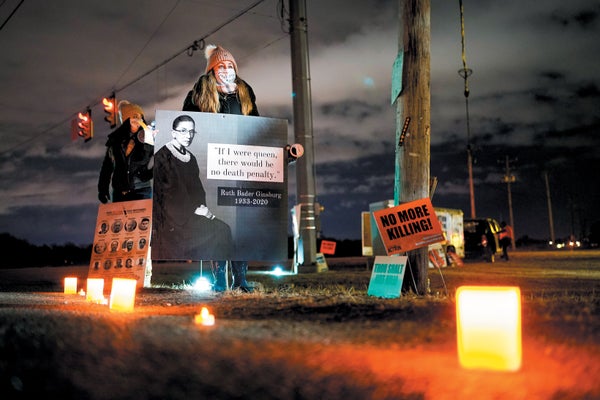
Evidence Does Not Support the Use of the Death Penalty
Capital punishment must come to an end. It does not deter crime, is not humane and has no moral or medical basis

It is long past time to abolish the death penalty in the U.S.
Capital punishment was halted in the U.S. in 1972 but reinstated in 1976, and since then, nearly 1,600 people have been executed. To whose gain? Study after study shows that the death penalty does not deter crime, puts innocent people to death, is racially biased, and is cruel and inhumane. It is state-sanctioned homicide, wholly ineffective, often botched, and a much more expensive punishment than life imprisonment. There is no ethical, scientifically supported, medically acceptable or morally justifiable way to carry it out.
The recent execution of Kenneth Eugene Smith demonstrates this barbarity. After a failed attempt at lethal injection by prison officials seemingly inexperienced in the placement of an IV, the state of Alabama killed Smith in January using nitrogen gas. The Alabama attorney general claimed that this method of execution was fast and humane, despite no supporting evidence. Eyewitnesses recounted that Smith thrashed during the nitrogen administration and took more than 20 minutes to die.
If you're enjoying this article, consider supporting our award-winning journalism by subscribing. By purchasing a subscription you are helping to ensure the future of impactful stories about the discoveries and ideas shaping our world today.
Opposition to the death penalty is growing among the American public, and the Biden administration must follow through on its promise to end this horror. The Department of Justice must heed its own admission that the death penalty doesn’t stop crime, and our legislators must continue to take up the issue on the congressional floor. The few states that still condemn people to death must follow the lead of states that have considered the evidence and rejected capital punishment.
Programs such as the Innocence Project have shown, over and over, that innocent people have been sentenced to death. Since 1973 nearly 200 people on death row have been exonerated, based on appeals, the reopening of cases, and the entrance of new and sometimes previously suppressed evidence. People have recanted testimony, and supposedly airtight cases have been poked full of evidentiary holes.
Through the death penalty, the criminal justice system has killed at least 20 people now believed to have been innocent and uncounted others whose cases have not been reexamined. Too many of these victims have been Black or Hispanic. This is not justice. These are state-sanctioned hate crimes.
Using rigorous statistical and experimental control methods, both economics and criminal justice studies have consistently found that there is no evidence for deterrence of violent crimes in states that allow capital punishment. One such study, a 2009 paper by criminology researchers at the University of Dallas, outlines experimental and statistical flaws in econometrics-based death penalty studies that claim to find a correlated reduction in violent crime. The death penalty does not stop people from killing. Executions don’t make us safer.
The methods used to kill prisoners are inhumane. Electrocution fails, causing significant pain and suffering. Joel Zivot, an anesthesiologist who criticizes the use of medicines in carrying out the death penalty, has found (at the request of lawyers of death row inmates) that the lungs of prisoners who were killed by lethal injection were often heavy with fluid and froth that suggested they were struggling to breathe and felt like they were drowning. Nitrogen gas is used in some veterinary euthanasia, but based in part on the behavior of rats in its presence, it is “unacceptable” for mammals, according to the American Veterinary Medical Association. This means that Smith, as his lawyers claimed in efforts to stop his execution, became a human subject in an immoral experiment.
Courts have often decided, against the abundant evidence, that these killings are constitutional and do not fall under the “cruel and unusual punishment” clause of the 8th Amendment or, in Smith’s appeal, both the 8th Amendment and the due process protection clause of the 14th amendment.
A small number of prosecutors and judges in a few states, mostly in the South, are responsible for most of the death sentences being handed down in the U.S. today. It’s a power they should not be able to wield. Smith was sentenced to life in prison by a jury before the judge in his case overruled the jury and gave him the death sentence.
A furious urge for vengeance against those who have done wrong—or those we think have done wrong—is the biggest motivation for the death penalty. But this desire for violent retribution is the very impulse that our criminal justice system is made to check, not abet. Elected officials need to reform this aspect of our justice system at both the state and federal levels. Capital punishment does not stop crime and mocks both justice and humanity. The death penalty in the U.S. must come to an end.
This is an opinion and analysis article, and the views expressed by the author or authors are not necessarily those of Scientific American.